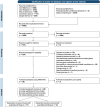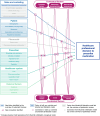A conceptual model of factors potentially influencing prescribing decisions for chronic conditions: an overview of systematic reviews
- PMID: 40598148
- PMCID: PMC12217990
- DOI: 10.1186/s12916-025-04194-9
A conceptual model of factors potentially influencing prescribing decisions for chronic conditions: an overview of systematic reviews
Abstract
Background: Nearly half of all adults are affected by chronic conditions with long-term medications often being the primary intervention. Although models like that of Murshid and Mohaidin contribute to our understanding of prescribing behaviours, they are not specific to chronic conditions and may not reflect the full range of influencing factors relevant to long-term care. Better understanding the factors that may influence healthcare professionals' decision-making could help inform policy and guidelines as well as identify targets for future research and interventions.
Methods: An overview of systematic reviews was undertaken, following the 2020 PRISMA guidelines. PubMed, Embase, Web of Science, Cochrane Library and Google Scholar were searched from 01/01/2013 to 7/11/2023. Quality assessment was undertaken using the AMSTAR 2 tool. Screening, data extraction and synthesis were conducted. Confidence in findings was assessed using the GRADE-CERQual tool. An existing generic conceptual model of prescribing was adjusted to specifically reflect chronic conditions.
Results: Twenty-six reviews published between 2013 and 2023 were included, synthesising 689 primary studies. Patient factors that may influence prescribers' decisions included age, ethnicity, education and level of rurality of residence. Prescribers describe assessing individual patient characteristics when weighing the risks and benefits, with a tendency to prioritise risks-especially for patients with multiple comorbidities or complex needs. Prescribers' approach to risk may be influenced by their clinical experience, care setting and assessment tools. High workload and competing priorities may lead to clinical inertia in terms of delaying or preventing medication initiation. Shared decision-making may not always be shared equally between patients and prescribers. Beyond direct medication costs, prescribers may also consider broader healthcare costs, such as the need for monitoring and use of support staff for monitoring. External factors such as guidelines may be helpful in navigating risks, with their effectiveness potentially enhanced when they offer specific recommendations tailored to prescribers' population characteristics.
Conclusions: Prescribers may need to navigate multiple challenges when making prescribing decisions for people with chronic conditions. This overview of systematic reviews suggests possible interrelated factor categories influencing prescribing decisions. The conceptual model may be used as a framework for future research and development of interventions.
Keywords: Chronic conditions; Chronic diseases; Decision-making; Long-term medications; Prescribing.
© 2025. The Author(s).
Conflict of interest statement
Declarations. Ethics approval and consent to participate: Not applicable. Consent for publication: Not applicable, no individual’s data or images were used in this review. Competing interests: The authors declare no competing interests.
Figures



Similar articles
-
Interventions to improve safe and effective medicines use by consumers: an overview of systematic reviews.Cochrane Database Syst Rev. 2014 Apr 29;2014(4):CD007768. doi: 10.1002/14651858.CD007768.pub3. Cochrane Database Syst Rev. 2014. PMID: 24777444 Free PMC article.
-
Factors that influence participation in physical activity for people with bipolar disorder: a synthesis of qualitative evidence.Cochrane Database Syst Rev. 2024 Jun 4;6(6):CD013557. doi: 10.1002/14651858.CD013557.pub2. Cochrane Database Syst Rev. 2024. PMID: 38837220 Free PMC article. Review.
-
Cost-effectiveness of using prognostic information to select women with breast cancer for adjuvant systemic therapy.Health Technol Assess. 2006 Sep;10(34):iii-iv, ix-xi, 1-204. doi: 10.3310/hta10340. Health Technol Assess. 2006. PMID: 16959170
-
Factors that influence parents' and informal caregivers' views and practices regarding routine childhood vaccination: a qualitative evidence synthesis.Cochrane Database Syst Rev. 2021 Oct 27;10(10):CD013265. doi: 10.1002/14651858.CD013265.pub2. Cochrane Database Syst Rev. 2021. PMID: 34706066 Free PMC article.
-
Falls prevention interventions for community-dwelling older adults: systematic review and meta-analysis of benefits, harms, and patient values and preferences.Syst Rev. 2024 Nov 26;13(1):289. doi: 10.1186/s13643-024-02681-3. Syst Rev. 2024. PMID: 39593159 Free PMC article.
References
-
- Australian Government. Prevalence of chronic conditions 2023.
-
- World Health Organization. Noncommunicable diseases - key facts 2023.
-
- Gordon J, Miller G, Britt H. What are chronic conditions that contribute to multimorbidity? Aust J Gen Pract. 2018;47:20–3. - PubMed
-
- National Center for Chronic Disease Prevention and Health Promotion (NCCDPHP). About chronic diseases 2023. - PubMed
Publication types
MeSH terms
LinkOut - more resources
Full Text Sources

